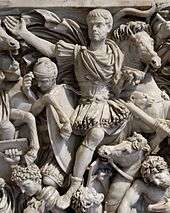Draco (military standard)

The draco ("dragon" or "serpent", plural dracones) was a military standard of the Roman cavalry. Carried by the draconarius, the draco was the standard of the cohort as the eagle (aquila) was that of the legion. [1]
The draco may have been introduced to the Roman cavalry by Sarmatian units in the 2nd century . According to Vegetius, in the 4th century a draco was carried by each legionary cohort.[2]
The dragon was originally a Dacian emblem. According to Fiebiger, the Romans adopted it from the Dacians, after their defeat [3] or from the Parthians.
Literary descriptions


The Greek military writer Arrian describes the draco in his passage on cavalry training exercises, calling it "Scythian":
The Scythian banners are dracontes held aloft on standard-length poles. They are made of colored cloths stitched together, and from the head along the entire body to the tail, they look like snakes. When the horses bearing these devices are not in motion, you see only variegated streamers hanging down. During the charge is when they most resemble creatures: they are inflated by the wind, and even make a sort of hissing sound as the air is forced through them.[4]
Arrian says the colorful banners offer visual pleasure and amazement, but also help the riders position themselves correctly in the complicated drills.[5] The Gallo-Roman Latin poet Sidonius offers a similar, if more empurpled, description.[6]
Depictions
The draco is depicted on the Ludovisi battle sarcophagus, above the horseman who is the central figure in the composition. It appears in several other reliefs, including the Arch of Galerius and the Arch of Constantine, both from the early 4th century.[7]

See also
- Dacian Draco
- Clan of Ostoja
- Olm (Proteus anguinus)-A species of cave Salamander of Slovenia locals call baby cave dragon
Notes
- ↑ Yust 1953, p. 570.
- ↑ Vegetius 2.13; Pat Southern and Karen R. Dixon, The Late Roman Army (Yale University Press, 1996), p. 98.
- ↑ Scott-Giles 1957, p. 16.
- ↑ Arrian, Technē Tacita 35.2–4.
- ↑ Arrian, Technē Tacita 35.5.
- ↑ Sidonius, Panegyric on Maiorianus 5; Southern and Dixon, The Late Roman Army, p. 126.
- ↑ Southern and Dixon, The Late Roman Army, p. 126.
References
- Scott-Giles, Charles Wilfrid (1957). The romance of heraldry. Dutton.
- Yust, Walter (1953). Encyclopædia Britannica: a new survey of universal knowledge:. Encyclopædia Britannica.